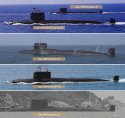This thread is about 09V and 09VI so I'll be brief with this digression. US Navy does control all the oceans through its Carrier groups and that situation will not change for the next 30 years. Might makes right. The beauty and elegance of the One Belt and One Road Initiative is to render this naval dominance completely irrelevant by shifting the geopolitical center of the world back to the Eurasian continent with overland connectivity (the maritime part was added later to make it sound more economic-oriented and all encompassing). Instead of spending a trillion dollars on instruments of destruction, using that same amount on infrastructures pays much better dividend by create brand new markets and more prosperous consumers while neatly removing the US from the entire picture. If you work remotely from home instead of commuting to office, do you care how dangerous or congested the traffic is? Why use oil tankers when you can have a pipeline from Iran to Xinjiang? Why use USD/SWIFT when you have DCEP (digital currency)? Why play with rules defined for your enemy's benefit (the so called 'International System')? Why bother with Saudi Arabia/UAE when you can build an alliance with Iraq/Iran/Syria/Afghanistan/Pakistan? Why sail the Indian ocean when you have the Northern Passage? Why sweat about selling 5G to an aging population of 500 million in NA and Europe now when your potential market 10 years from now can be five billion people in Africa, Latin America, and Asia?
Great generals win by maneuvering/out flanking the enemy, not by frontal assaults or play into your enemy's strengths. China's strategy has been to bypass areas where US is dominant and leave the US with all the legacy weapons and doctrines. The US Navy is probably the service China worry about the least. USN hasn't come up with a single successful hull design since the Spruance 50 years ago. Zumwalt and LCS are complete disasters. Ford class is being capped at 4 and the Marines no longer have any purpose at all. China's A2/AD strategy is working really well. What good is your CVN if your plane's range + weapon range won't even reach your enemy's coastline? Waiting until China is more resilient in finance and high tech, then it is time to sell Iran MARV technology to keep the Hormuz clear.
Back to the 09V quantity question. 36 is more than plenty (I was actually thinking 24 09V's and 12 09VI's). (1) Although it is hard to imagine a cheaper form of transportation, China can reduce its dependence and criticality to its national interests. (2) Don't forget the diesels which are inherently quieter and an order of magnitude cheaper life cycle cost. We are at the very beginning of the endurance/AIP revolution. When a diesel can go a month or two underwater, why bother with nuclear? (3) Why use a manned sub for land targets when a submersible arsenal ship (or a swarming mothership from above) can do more for much less. (4) A poor country (like Vietnam) must buy these small Jack-of-all-trades frigates overloaded with all sorts of weapons. When you are rich, you can afford to build 05VI corvettes knowing you have 05IV's, 05II's, and 05V's for the tougher jobs.
Let the 09V's be dedicated SSN hunter killers. With longer range SLBM's, the SSBN's can stay in Bohai which is already a safe-enough bastion. I think the 05VI corvette design shows China recognizes the usefulness of dedicated platforms. US wishes it can do this too but its cost structure is way too high and it has failed too many times that it must adapt the FREMM design for the Constellation class of frigates. If you follow US submarine discussions, USN thinks the Virginia is too small and the follow-on class will be substantially bigger but can the US afford such a Seawolf-like boat.
There are a key analytical error at the beginning of your analysis.
Overland road and rail connectivity is many more times expensive than sea freight.
For China-India and China-Europe trade for example, seaborne transport is a lot cheaper than rail
This is why over 90% of China's trade is seaborne, and this won't change much because transport costs are based on physical limits
So your assertion that Belt and Road Initiative will put the focus back to the Eurasian continent is not going to happen.
And you mention many other countries in the rest of the world.
It's not practical to use overland connections, so this freight has to be seaborne.
---
And remember that China is already the world's largest trading nation and the largest economy in terms of actual physical output.
China is also aiming to double the size of the economy from 2020-2035, and we can also see R&D spending continuing on an explosive growth path.
So by 2035, it's possible for China to have an economy twice the size of the USA, and also be spending twice as much on technology R&D.
So I think it highly unlikely that the China would be satisfied with only 36 SSNs (as you suggest) and accepting that its overseas trade is subject to the control of a larger US Navy.
More likely is a Chinese Navy that aspires to global sea control to protect global trade from the US Navy.
That requires the Chinese Navy to be larger than the US equivalent.

